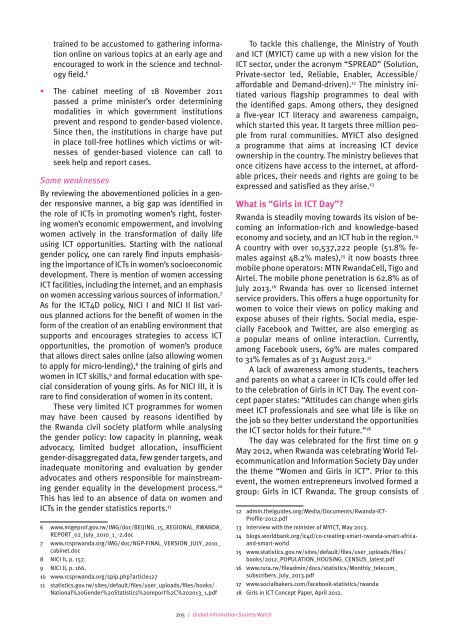gisw13_chapters
gisw13_chapters
gisw13_chapters
Create successful ePaper yourself
Turn your PDF publications into a flip-book with our unique Google optimized e-Paper software.
trained to be accustomed to gathering informationonline on various topics at an early age andencouraged to work in the science and technologyfield. 6• The cabinet meeting of 18 November 2011passed a prime minister’s order determiningmodalities in which government institutionsprevent and respond to gender-based violence.Since then, the institutions in charge have putin place toll-free hotlines which victims or witnessesof gender-based violence can call toseek help and report cases.Some weaknessesBy reviewing the abovementioned policies in a genderresponsive manner, a big gap was identified inthe role of ICTs in promoting women’s right, fosteringwomen’s economic empowerment, and involvingwomen actively in the transformation of daily lifeusing ICT opportunities. Starting with the nationalgender policy, one can rarely find inputs emphasisingthe importance of ICTs in women’s socioeconomicdevelopment. There is mention of women accessingICT facilities, including the internet, and an emphasison women accessing various sources of information. 7As for the ICT4D policy, NICI I and NICI II list variousplanned actions for the benefit of women in theform of the creation of an enabling environment thatsupports and encourages strategies to access ICTopportunities, the promotion of women’s producethat allows direct sales online (also allowing womento apply for micro-lending), 8 the training of girls andwomen in ICT skills, 9 and formal education with specialconsideration of young girls. As for NICI III, it israre to find consideration of women in its content.These very limited ICT programmes for womenmay have been caused by reasons identified bythe Rwanda civil society platform while analysingthe gender policy: low capacity in planning, weakadvocacy, limited budget allocation, insufficientgender-disaggregated data, few gender targets, andinadequate monitoring and evaluation by genderadvocates and others responsible for mainstreaminggender equality in the development process. 10This has led to an absence of data on women andICTs in the gender statistics reports. 116 www.migeprof.gov.rw/IMG/doc/BEIJING_15_REGIONAL_RWANDA_REPORT_02_July_2010_1_-2.doc7 www.rcsprwanda.org/IMG/doc/NGP-FINAL_VERSION_JULY_2010_cabinet.doc8 NICI II, p. 157.9 NICI II, p. 166.10 www.rcsprwanda.org/spip.php?article12711 statistics.gov.rw/sites/default/files/user_uploads/files/books/National%20Gender%20Statistics%20report%2C%202013_1.pdfTo tackle this challenge, the Ministry of Youthand ICT (MYICT) came up with a new vision for theICT sector, under the acronym “SPREAD” (Solution,Private-sector led, Reliable, Enabler, Accessible/affordable and Demand-driven). 12 The ministry initiatedvarious flagship programmes to deal withthe identified gaps. Among others, they designeda five-year ICT literacy and awareness campaign,which started this year. It targets three million peoplefrom rural communities. MYICT also designeda programme that aims at increasing ICT deviceownership in the country. The ministry believes thatonce citizens have access to the internet, at affordableprices, their needs and rights are going to beexpressed and satisfied as they arise. 13What is “Girls in ICT Day”?Rwanda is steadily moving towards its vision of becomingan information-rich and knowledge-basedeconomy and society, and an ICT hub in the region. 14A country with over 10,537,222 people (51.8% femalesagainst 48.2% males), 15 it now boasts threemobile phone operators: MTN RwandaCell, Tigo andAirtel. The mobile phone penetration is 62.8% as ofJuly 2013. 16 Rwanda has over 10 licensed internetservice providers. This offers a huge opportunity forwomen to voice their views on policy making andexpose abuses of their rights. Social media, especiallyFacebook and Twitter, are also emerging asa popular means of online interaction. Currently,among Facebook users, 69% are males comparedto 31% females as of 31 August 2013. 17A lack of awareness among students, teachersand parents on what a career in ICTs could offer ledto the celebration of Girls in ICT Day. The event conceptpaper states: “Attitudes can change when girlsmeet ICT professionals and see what life is like onthe job so they better understand the opportunitiesthe ICT sector holds for their future.” 18The day was celebrated for the first time on 9May 2012, when Rwanda was celebrating World Telecommunicationand Information Society Day underthe theme “Women and Girls in ICT”. Prior to thisevent, the women entrepreneurs involved formed agroup: Girls in ICT Rwanda. The group consists of12 admin.theiguides.org/Media/Documents/Rwanda-ICT-Profile-2012.pdf13 Interview with the minister of MYICT, May 2013.14 blogs.worldbank.org/ic4d/co-creating-smart-rwanda-smart-africaand-smart-world15 www.statistics.gov.rw/sites/default/files/user_uploads/files/books/2012_POPULATION_HOUSING_CENSUS_latest.pdf16 www.rura.rw/fileadmin/docs/statistics/Monthly_telecom_subscribers_July_2013.pdf17 www.socialbakers.com/facebook-statistics/rwanda18 Girls in ICT Concept Paper, April 2012.205 / Global Information Society Watch


